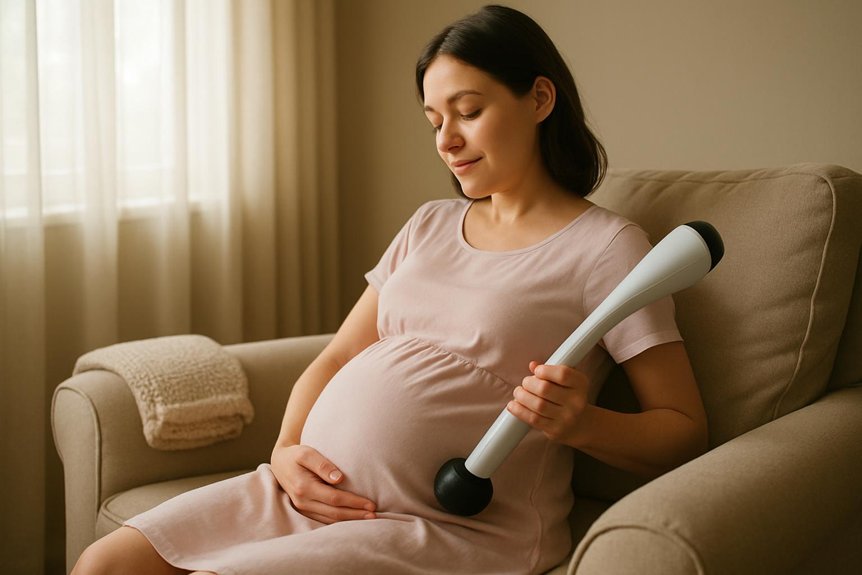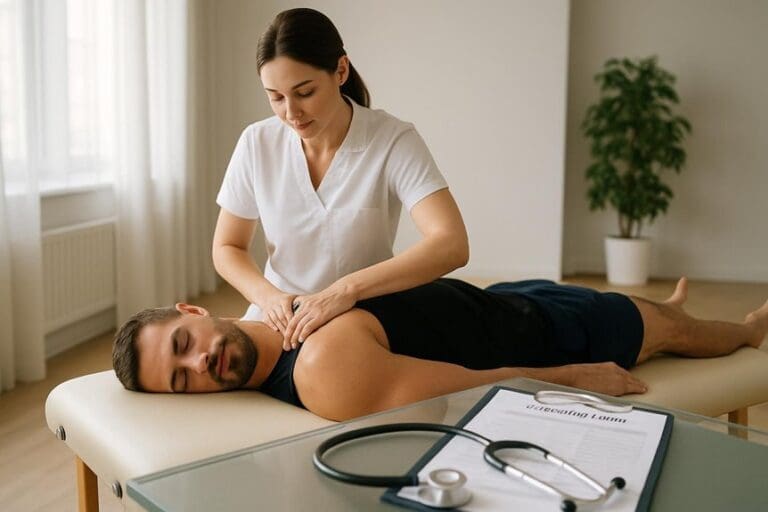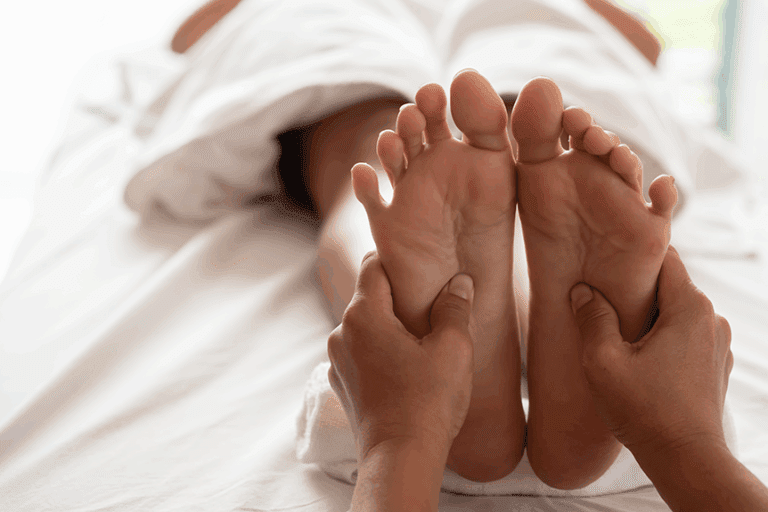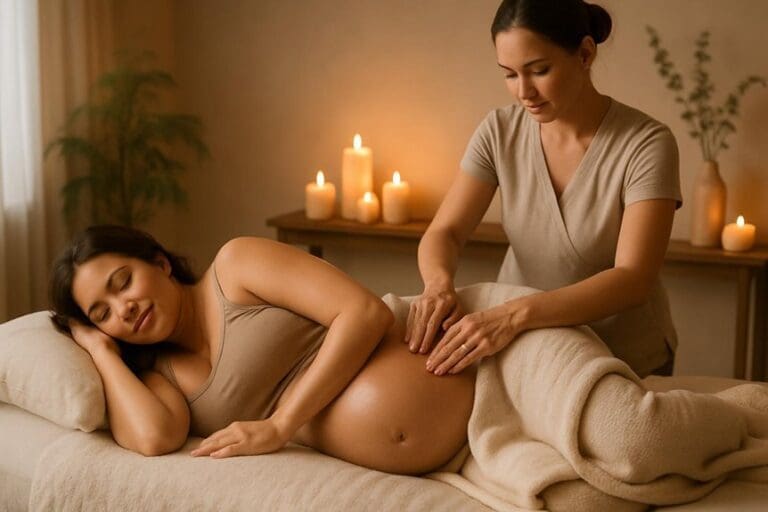Yes—many can use electric massagers in pregnancy with caution. Choose low-intensity, non-percussive, non-heat or mild-heat settings. Limit to 5–10 minutes per region and avoid the abdomen, lower back over the sacrum, inner thighs, and acupressure points linked to uterine activity. Target shoulders, mid-back, hips, calves, feet, and glutes. Stop immediately for dizziness, tightening, bleeding, or persistent pain. High-risk pregnancies need clinician clearance. Keep comfort first, use gentle vibration, and adjust by trimester to stay safe—more guidance follows.
Is It Safe to Use an Electric Massager While Pregnant?
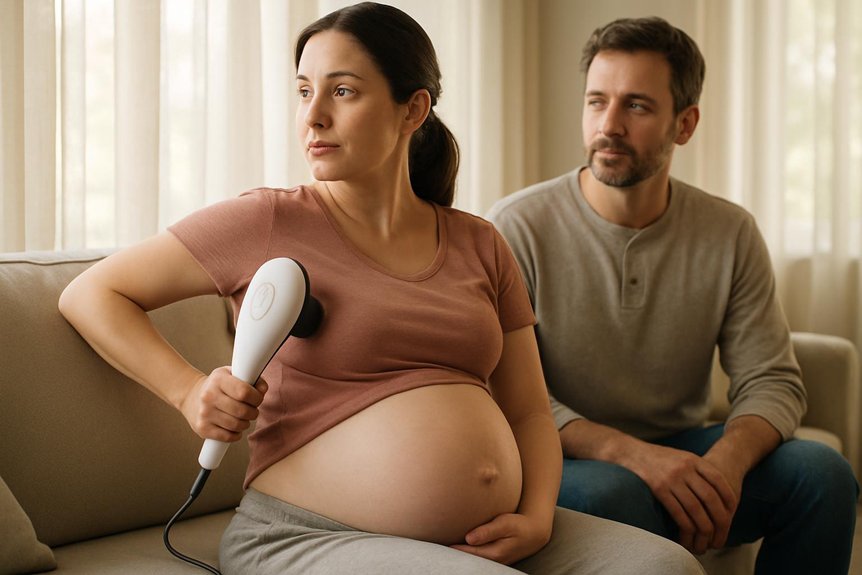
While many expectant parents seek relief from aches and tension, safety must guide any use of electric massagers during pregnancy.
Evidence suggests low-intensity, non-heat, non-percussive devices used briefly on non-abdominal areas are generally low risk when pregnancy is uncomplicated.
Caution is essential: avoid the bump, lower back after mid-pregnancy, and any settings that cause vibration deep into the pelvis.
Steer clear of high heat, strong percussion, or massage over varicose veins, numb areas, rashes, or where there is bleeding risk.
Spa & Massage advises a conversation with a midwife or obstetrician first—especially with placenta concerns, preeclampsia, reduced fetal movements, or a history of preterm labour.
In our clinics, therapists favour gentle, pregnancy-appropriate techniques and clear positioning guidance, prioritising maternal comfort, circulation, and safety.
For additional support, relax and heal with aromatherapy massage tips that complement gentle massage therapy approaches during pregnancy.
Benefits and When Electric Massagers Can Help
Although caution remains essential, electric massagers can provide targeted relief for common musculoskeletal discomforts in pregnancy when used appropriately.
Evidence suggests gentle, localized vibration or kneading can ease low‑back and hip tension, reduce calf cramps, and support circulation in swollen feet and ankles.
Short sessions may also down‑regulate stress responses, helping sleep settle more easily.
They are most helpful between routine antenatal appointments when tightness builds: after long commutes, desk work, or nights of disrupted rest.
Many benefit from brief use on the upper back, glutes, or feet, while avoiding the abdomen and any areas with varicosities or numbness.
At Spa & Massage in London, therapists guide clients to pair home devices with professional pregnancy massage, emphasizing low intensity, time limits, and symptom‑led use.
Types of Devices and Settings to Choose or Avoid
When selecting an at‑home device in pregnancy, Spa & Massage advises prioritising simple, low‑to‑moderate intensity options such as handheld vibrating massagers for limbs, foam rollers, and heat pads with automatic shut‑off.
Settings to avoid include deep percussive guns on the abdomen or lower back, high‑heat modes, high‑intensity or prolonged pressure, and any device with electrical stimulation (TENS) unless cleared by a maternity clinician.
Their therapists also caution against using massage heads over acupressure trigger points linked to uterine activity and recommend short, well‑tolerated sessions with frequent check‑ins for comfort.
Safe Device Options
Because safety is paramount in pregnancy, the most suitable electric massagers are low-intensity, surface-level devices with adjustable settings, such as gentle vibration or soft kneading heads used on non-abdominal areas.
Evidence suggests light, localized vibration can ease muscle tension without affecting uterine blood flow when kept brief and comfortable. Handheld vibrators with soft silicone heads, padded percussive units on low power, and warming pads with regulated temperatures are typically acceptable for shoulders, upper back, hips, calves, and feet.
For intimate reassurance, devices that allow precise control—timers, incremental intensity, and wide, cushioned contact—help maintain comfort and safety. In our Spa & Massage clinics, therapists recommend short sessions, ample cushioning, and pregnancy-safe body positioning to protect joints and circulation, mirroring how expectant clients can use home devices thoughtfully.
Settings to Avoid
How can expectant parents tell which massage settings are too intense? Evidence and maternity guidelines point to avoiding percussive “hammer” modes, deep-knead nodes on high, heat above 40°C, and prolonged vibration over the lower back, abdomen, or sacrum.
Any setting that causes breath-holding, guarding, tingling, or lingering soreness is too strong. Intensity should stay at the lowest effective level, with sessions limited to 10–15 minutes per region.
At Spa & Massage clinics in London, therapists avoid pressure over the abdomen and use gentle, continuous strokes rather than rapid pulses. They recommend soft-to-medium intensity, no heat in the first trimester, and no settings that create numbing or pins-and-needles.
Clients are guided to stop immediately if baby movements change, dizziness appears, or discomfort persists.
Areas to Target vs. Areas to Skip During Each Trimester
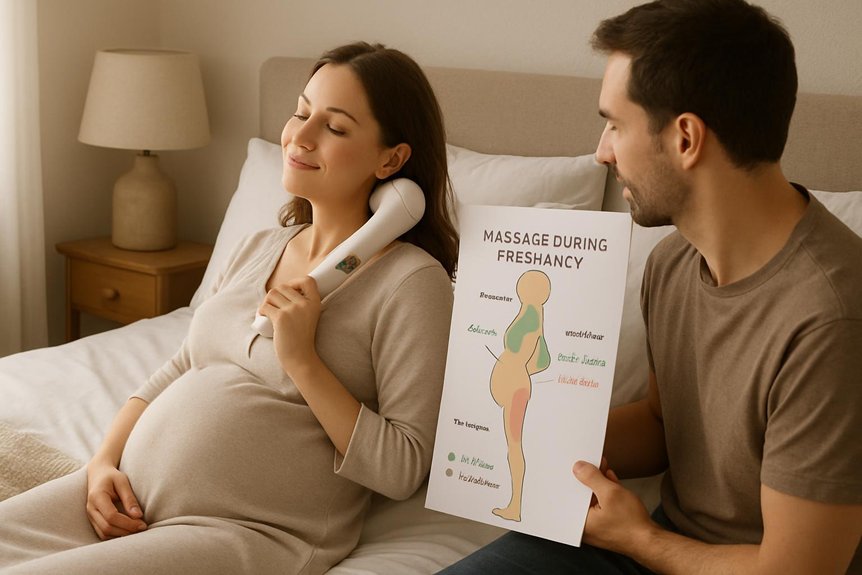
In each trimester, targeted use of an electric massager should balance symptom relief with maternal and fetal safety, adjusting both areas and intensity as the body changes. Evidence supports cautious first-trimester focus on general relaxation (neck, shoulders, calves, feet arches) while avoiding abdomen, lower back over the sacrum, and acupressure points linked to uterine activity.
The second trimester allows broader work on mid-back and hips with the same exclusions, and the third trimester warrants extra caution around edema, varicosities, and sensitive pelvic regions.
At Spa & Massage, therapists guide clients trimester-by-trimester to prioritise safe zones and skip higher-risk areas, adapting pressure and duration accordingly.
First Trimester Focus
Early in pregnancy, caution matters most: during the first trimester, Spa & Massage therapists prioritise gentle, calming work to reduce stress and support sleep while avoiding techniques that could increase risk or discomfort.
Evidence suggests heightened nausea, fatigue, and temperature sensitivity are common, so light hand techniques to the upper back, neck, scalp, forearms, calves, and feet (without acupressure to known induction points) are preferred.
If using an electric massager at home, they recommend low settings, short durations, and avoiding heat if dizziness or overheating occurs.
Areas to skip include: abdomen, deep gluteal work, strong lumbar pressure, and any vibration directly over the pelvis.
Therapists avoid trigger-point intensity and percussive devices.
Hydration, slow position changes, left-side-lying comfort, and immediate cessation with any cramping, spotting, or lightheadedness are advised.
Second Trimester Dos/Don’Ts
By the second trimester, many find nausea easing and energy improving, allowing a broader—but still cautious—approach to massage and home electric devices.
Spa & Massage advises targeting the mid-back, glutes, hips, calves, and feet for circulation and postural relief. Gentle vibration or low-intensity percussive settings can be used briefly on tight muscles, avoiding heat that raises core temperature.
Areas to skip include the abdomen, inner thighs, and any acupressure points linked to uterine activity (e.g., around the ankles, thumb–index web). Avoid sustained pressure over the lower back midline and any area with varicose veins or numbness.
Keep sessions short, hydrated, and never to the point of pain. Our therapists recommend side-lying positioning, unscented or mild citrus oils, and pausing immediately if dizziness, cramping, or spotting occurs.
Third Trimester Cautions
Although comfort often narrows as the due date nears, the third trimester calls for stricter targeting and gentler settings with any electric massager.
Evidence and clinical practice highlight low-risk areas: mid-back, shoulders, calves, feet (avoiding strong pressure on reflex points), forearms, and hips/glutes with light, steady vibration.
Short sessions—5–10 minutes per region—help manage swelling and tension without overstimulation.
Areas to skip include the abdomen, lower back over the sacrum with deep or percussive devices, inner thighs (due to clot risk), and any direct pressure near the ankles’ known induction points.
Avoid heat if there is swelling, reduced sensation, or signs of preeclampsia.
At Spa & Massage in London, therapists favour side-lying positioning, soft settings, and slow pacing.
They recommend medical clearance for high-risk pregnancies and advise stopping immediately with dizziness, cramping, or unusual discharge.
How We Adapt Massage at Spa & Massage for Pregnancy
When welcoming someone who is expecting, Spa & Massage applies pregnancy-specific protocols to support comfort and safety while delivering meaningful relief. Therapists confirm gestational stage, health history, and preferences.
They then use evidence-based positioning—primarily side-lying with supportive bolsters—to protect circulation and ease lumbar load. Pressure is moderated and targeted to common concerns: low back, hips, glutes, shoulders, and swollen legs, while avoiding contraindicated points and sustained deep work over the abdomen.
In our London clinics, neutral, plant-based oils are selected to reduce scent sensitivity and skin reactivity. Techniques emphasize slow, rhythmic strokes, myofascial release, and gentle mobilisations to downshift the nervous system.
For clients curious about electric massagers, therapists prioritise hands-on work and may suggest safer, low-intensity alternatives between appointments, aligned with their comfort and clinician guidance.
Practical Safety Tips and Red Flags to Watch For

Even with simple, home-use devices, pregnancy warrants a conservative approach that prioritises maternal and fetal safety.
Spa & Massage advises low-intensity settings, brief sessions (5–10 minutes per area), and avoiding the abdomen, lower back over the uterus, inner thighs, and any acupressure points linked with uterine activity.
Heat should be mild; skin must remain comfortably warm, never hot. Devices with percussive heads or strong vibration should not be used near the pelvis.
Red flags that require stopping immediately include: dizziness, uterine tightening, pelvic pressure, vaginal bleeding or fluid loss, reduced fetal movements, new swelling, numbness, or pain that lingers after use.
Do not use over varicose veins, bruises, rashes, or areas with decreased sensation.
Those with placenta previa, preeclampsia, or preterm risk should seek clinician guidance before any device use.
Alternatives to Devices: Therapist-Guided Options and Home Self-Care
While handheld massagers can be useful, safer, low-tech options often meet pregnancy needs more reliably. From Spa & Massage’s perspective, therapist-guided prenatal massage offers precise pressure, side-lying positioning, and contraindication screening—crucial for low back pain, pelvic discomfort, and swelling.
Our therapists use unscented or mild aromatherapy blends and avoid abdominal compression, deep gluteal trigger points, and strong heat.
At home, simple practices help: supported side-lying with pillows, gentle hip and calf stretches, diaphragmatic breathing, and slow foam rolling on the upper back only. A warm (not hot) bath and ankle-to-knee self-stroking can ease fatigue and encourage circulation.
For headaches, our therapists recommend scalp and jaw release and a cool compress.
Seek medical guidance with placenta complications, preeclampsia, unexplained pain, or decreased fetal movement.
Conclusion
In sum, electric massagers can be used cautiously in pregnancy with gentle settings, safe body areas, and clinician guidance. Evidence supports reduced back pain and improved sleep when devices avoid abdomen, deep vibration, and heat extremes. Picture Maya at 26 weeks, easing calf cramps with a low-intensity foot roller for 10 minutes after her midwife’s okay, then booking a side-lying prenatal session at Spa & Massage. She feels lighter, swelling eases, and she knows what to stop if any warning signs appear.
